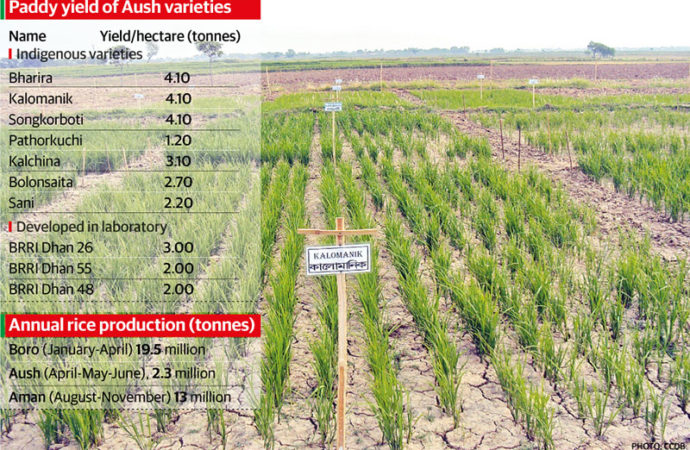Indigenous Aush varieties now top priority

The indigenous varieties of rain-fed Aush paddy are likely to lead the country’s future rice production, instead of the irrigation-reliant Boro, since it may work as a natural remedy to check the drastic depletion of groundwater table in drought-prone areas. Even though per hectare Aush production is slightly below than that of Boro, a number of scientists including a former BRRI chief suggest that farmers should prioritise Aush as it does not need irrigation or even rain to grow. A recent study shows that the indigenous Aush varieties like Bharira, Kalomanik, Songkorboti, Pathorkuchi, Kalchina, Bolonsaita and Sani can produce more rice than the varieties developed by Bangladesh Rice Research Institute. Also, the study finds that the local varieties can better cope with the country’s changing climatic pattern. Christian Commission for the Development of Bangladesh (CCDB) recently ran a trial on Aush varieties in drought condition at Godagari upazila in Rajshahi – considered as the core zone of Upland Barind Tract where drought has been a natural phenomenon since long. According to their findings, local varieties Bharira, Kalomanik and Songkorboti can produce 4.10 tonnes of paddy per hectare. On the other hand, BRRI Dhan 26 developed by the Bangladesh Rice Research Institute yields 3 tonnes while BRRI Dhan 55 and BRRI Dhan 48 yield 2 tonnes of paddy each without irrigation. The results came at a time when the government has been trying to reduce the cultivation of extensive irrigation-dependent Boro despite its highest production capacity, around 4.73 tonnes rice per hectare. According to the Agriculture Ministry, Bangladesh produces around 34.8 million tonnes of rice against the annual demand of 32.4m tonnes. Boro is the highest cultivated paddy in Bangladesh with around 19.5m tonnes of rice yield annually, followed by Aman (around 13m tonnes) and Aush (2.3m tonnes). According to BRRI, the country has around 12,000 indigenous rice varieties and most of them have been preserved by the state-run research body. Agriculture Minister Matia Chowdhury has repeatedly been taking different initiatives including incentive packages to promote Aush cultivation among the farmers for the last couple of years. The package includes seeds, fertilisers and cash assistance. The researchers found that after spending Tk39,875 per hectare for all the 10 Aush varieties (seven indigenous and three BRRI developed), local varieties Bharira, Kalomanik and Songkorboti give the highest net return of Tk62,625. On the other hand, laboratory-developed variety BRRI Dhan gave Tk35,125 net return while BRRI Dhan 55 and BRRI Dhan 48 fetched Tk10,125. “These findings show that now we can easily turn to Aush from Boro to avoid the excessive water consumption from groundwater table,” Jibon Krishna Biswas, former director general of BRRI, told the Dhaka Tribune. The Barind Tract – comprising Rajshahi, Chapainawabganj and Naogaon districts – sees lesser rain than other parts of the country. According to Bangladesh Meteorological Department, the number of normal rainy days in the Barind Tract in April, May, June and July are 6, 10, 12 and 15 days. “We observed 21 non-stop rainless days during the trial run starting from April 10 this year, and in the end, the local varieties gave us better yield as well as return despite the rough condition,” said Kamruzzaman Sagor, coordinator (research) of CCDB who led the trial.
Read More: http://www.dhakatribune.com/bangladesh/2016/10/08/indigenous-aush-varieties-now-top-priority/

